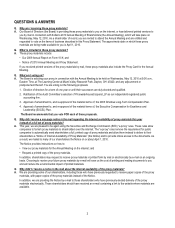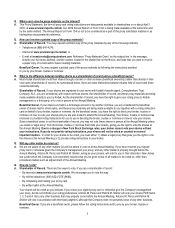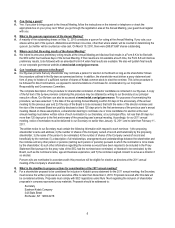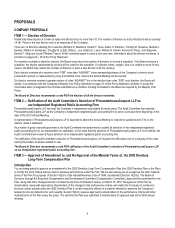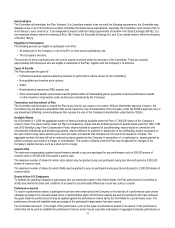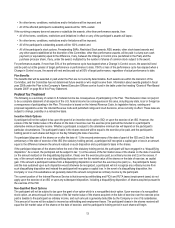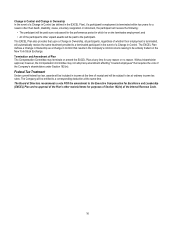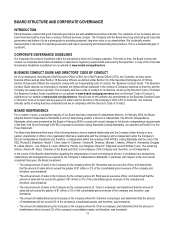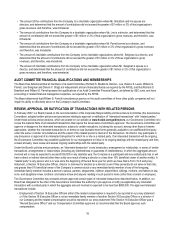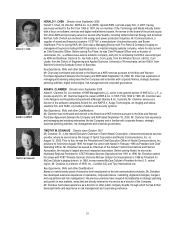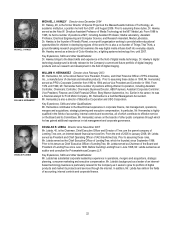Kodak 2009 Annual Report Download - page 156
Download and view the complete annual report
Please find page 156 of the 2009 Kodak annual report below. You can navigate through the pages in the report by either clicking on the pages listed below, or by using the keyword search tool below to find specific information within the annual report.12
performance of a subsidiary, division, strategic product group, segment, business unit or one or more product lines; and 4) how to apply
the performance formula.
Performance awards granted to “covered employees” are intended to comply with Section 162(m). The performance criteria that the
Committee may select for such awards are described above.
Stock Options
The Committee may grant awards in the form of stock options to purchase shares of the Company’s common stock. For each stock option
grant, the Committee will determine the number of shares subject to the option and the manner and time of the option’s exercise, provided
that no stock option will be exercisable after seven years from the date of its grant. The minimum vesting schedule for a stock option is one
year unless the participant’s employment is terminated under certain circumstances or if there is a Change in Control (as defined in the
Plan) of the Company. The exercise price of a stock option may not be less than 100% of the fair market value of the Company’s common
stock on the date the stock option is granted. Upon exercise, a participant may pay the exercise price in cash, shares of common stock, a
combination thereof or such other consideration as the Committee determines. The Plan prohibits: 1) lowering of the option price per share
after the option is granted; 2) cancelling of a stock option when the option price per share exceeds the fair market value of the underlying
shares; or 3) any action that would be considered repricing under the rules and regulations of the NYSE, in each case, without shareholder
approval. Any stock option granted in the form of an incentive stock option is intended to satisfy the requirements of Section 422 of the
Internal Revenue Code.
Stock Appreciation Rights
The Committee may grant SARs either in tandem with a stock option (Tandem SARs) or independent of a stock option (Freestanding
SARs).
A Tandem SAR may be granted at the time of the grant of the related stock option. A Tandem SAR will be exercisable to the extent its
related stock option is exercisable, and the exercise price of such a SAR will be the same as the option price of its related stock option,
which may not be less than 100% of the fair market value of the Company’s common stock on the date the SAR is granted. Upon the
exercise of a stock option as to some or all of the shares covered by the award, the related Tandem SAR will automatically be cancelled to
the extent of the number of shares covered by the stock option exercise.
The Committee will determine the number of shares subject to a Freestanding SAR and the manner and time of the SAR’s exercise.
Freestanding SARs must be granted for a term of seven years or less and may generally have the same terms and conditions as stock
options. The exercise price of a Freestanding SAR may not be less than 100% of the fair market value of the Company’s common stock on
the date of grant.
For both Tandem and Freestanding SARs, the Plan prohibits: 1) lowering of the exercise price of an SAR after it is granted; 2) cancelling of
an SAR when the exercise price exceeds the fair market value of the Company’s common stock; or 3) any action that would be considered
repricing under the rules and regulations of the NYSE, in each case, without shareholder approval.
Other Awards
Awards may be granted in the form of Restricted Stock awards, RSU awards and other stock-based awards. These awards are subject to
such terms, restrictions and conditions as the Committee may determine. Restricted stock awards and RSU awards granted in the form of
freestanding grants will have a minimum vesting requirement of three years unless the participant’s employment is terminated under
certain circumstances or if there is a Change in Control of the Company. However, Restricted Stock awards and RSU awards granted to
new hires to replace forfeited awards from a prior employer are not subject to a minimum vesting requirement, and vesting on a graded
basis is permissible in all cases. Other stock-based awards granted in the form of deferred stock units are not subject to a minimum
vesting period.
Other Terms
Awards may be paid in cash, common stock, a combination of cash and common stock, or any other form of property as the Committee
may determine. For stock-based awards, the Committee may include as part of the award an entitlement to receive dividends or dividend
equivalents. At the discretion of the Committee, a participant may defer payment of a stock-based award, performance award, dividend or
dividend equivalent.
Change in Control
In the event of a Change in Control, if outstanding awards, other than performance awards, are assumed or substituted by the surviving
company, as determined by the Committee, then the awards will not immediately vest or be exercisable. If awards are assumed or
substituted by the surviving company and, within two years following the Change in Control, a participant’s employment is terminated for a
reason other than death, disability, voluntary resignation, retirement or one of the following reasons: 1) the willful and continued failure by
the participant to substantially perform his or her duties or 2) the willful engagement by the participant in illegal conduct which is materially
and demonstrably injurious to the Company or a subsidiary, the participant will receive the following treatment:
• All of the terms, conditions, restrictions and limitations in effect on any of the affected participant’s awards will lapse;


